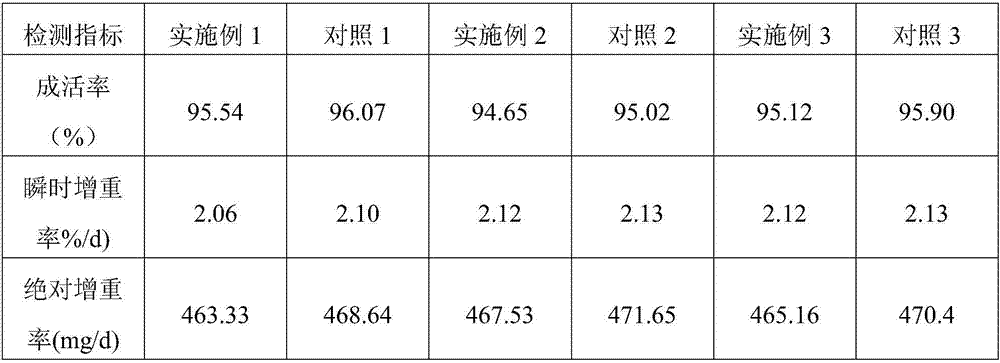Tilapia saline water aquaculture method
A culture method and tilapia technology, applied in fish farming, application, climate change adaptation and other directions, can solve the problems of limited aquaculture production, earthy smell, poor salt tolerance, etc., and achieve good flavor of tilapia meat. , the effect of expanding the breeding area and the high survival rate of fry
- Summary
- Abstract
- Description
- Claims
- Application Information
AI Technical Summary
Problems solved by technology
Method used
Image
Examples
Embodiment 1
[0038] Test fish: Nile tilapia, tilapia fry to be domesticated for salt tolerance weighs 5-7 grams, with complete scales and fin rays, no trauma, and strong vitality.
[0039] Salt water used in the test: sea crystal and groundwater (salinity 0) are configured, and the salinity of the water body is 11‰.
[0040] The tilapia feed used in the test is a commercially available tilapia special compound feed, and the feed formula is the same as the standard "Tilapia Compound Feed".
[0041] The tilapia saltwater culture method comprises the steps:
[0042] 1) Seedlings in cement ponds (6.0m×5.0m×1.6m) were salt-tolerant and domesticated for 3 days, 200 were stocked in each pond, and the salinity was increased by 2‰ every day without feeding.
[0043] 2) Continue the salt-tolerant domestication for 3 days, increase the salinity by 0.8‰ every day, gradually increase the feeding amount, and reach the normal feeding amount on the third day, change the water once every morning, and the ...
Embodiment 2
[0048] Test fish: Nile tilapia, tilapia fry to be domesticated for salt tolerance weighs 8-10 grams, with complete scales and fin rays, no trauma, and strong vitality.
[0049] Salt water for the test: sea salt and ground water (salinity 0), the salinity of the water body is 11g / L.
[0050] The tilapia feed used in the test is a commercially available tilapia special compound feed, and the feed formula is the same as the standard "Tilapia Compound Feed".
[0051] The tilapia saltwater culture method comprises the steps:
[0052] 1) Seedlings in cement ponds (6.0m×5.0m×1.6m) were salt-tolerant and domesticated for 3 days, and 100 tails were stocked in each pond, and the salinity was increased by 2g / L every day without feeding.
[0053] 2) Continue the salt-tolerant domestication for 3 days, increase the salinity by 0.8g / L every day, gradually increase the feeding amount, and change the water once every morning to 50% of the total volume until the third day reaches the normal f...
Embodiment 3
[0058] Test fish: Nile tilapia, tilapia fry to be domesticated for salt tolerance weighs 7-9 grams, with complete scales and fin rays, no trauma, and strong vitality.
[0059] Salt water for the test: sea salt and ground water (salinity 0), the water salinity is 10g / L.
[0060] The tilapia feed used in the test is a commercially available tilapia special compound feed, and the feed formula is the same as the standard "Tilapia Compound Feed".
[0061] The tilapia saltwater culture method comprises the steps:
[0062] 1) Seedlings in cement ponds (6.0m×5.0m×1.6m) were salt-tolerant and domesticated for 3 days, and 150 fish were stocked in each pond, and the salinity was increased by 1.5g / L every day without feeding.
[0063] 2) Continue the salt-tolerant domestication for 3 days, increase the salinity by 0.8g / L every day, gradually increase the feeding amount, and change the water once every morning to 50% of the total volume until the normal feeding amount is reached on the se...
PUM
 Login to View More
Login to View More Abstract
Description
Claims
Application Information
 Login to View More
Login to View More - R&D
- Intellectual Property
- Life Sciences
- Materials
- Tech Scout
- Unparalleled Data Quality
- Higher Quality Content
- 60% Fewer Hallucinations
Browse by: Latest US Patents, China's latest patents, Technical Efficacy Thesaurus, Application Domain, Technology Topic, Popular Technical Reports.
© 2025 PatSnap. All rights reserved.Legal|Privacy policy|Modern Slavery Act Transparency Statement|Sitemap|About US| Contact US: help@patsnap.com


